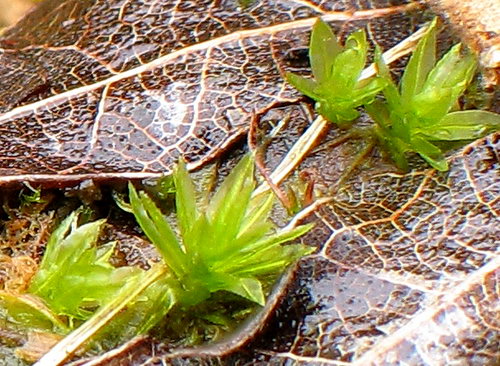
1 Plant thallose — Thallose liverworts
Plant leafy — 2
2 Leaves arranged either strictly in 2 ranks or in 3 ranks (one on each side of the stem and one in mid-ventral line); the leaves themselves most commonly round or 2-lobed, without nerves (sometimes leaves are so deeply divided as to appear 4- or 5-ranked) — Leafy liverworts
(N.B. Two mosses, Schistostega pennata and Fontinalis antipyretica, would' key out' here on this definition, but under the microscope both would be instantly recognized as mosses by their uniformly elongated leaf cells.)
Leaves not arranged strictly in ranks (except in Fissidens which has nerved leaves); the leaves themselves never 2-lobed, most of ten 'tapering to an acute or rounded apex, with or without nerves — 3 (Mosses)
3 Plants consisting of numerous upright stems on which branches arise strictly in whorls; all are bog or wet-ground plants which look pale when dry but are vivid green, orange-brown or purple-red when wet, and hold water like a sponge — Sphagnum
Plants never showing the regular whorled branching of Sphagnum. Never (except Leucobryum) sponge-like bog plants — 4
4 'Moss' consisting of numerous separate upright or ascending shoots which are simple, forked, or with a few short lateral branches; leaves very seldom like thin glossy scales; capsule normally terminal (but appearing lateral in some species of Fissidens, Rhacomitrium, etc.) — 5 (Acrocarps) (for more details about acrocarps/pleurocarps)
'Moss' usually consisting of a 'mat-like' growth of much branched stems, which are irregularly intertwined and most often prostrate or arched; branching most often pinnate (occasionally growth is upright from a horizontal stolon, branched above to give plant 'miniature tree' habit, e.g. Climacium); leaves most often like thin glossy scales; capsule always borne laterally. — 10 (Pleurocarps) (see the note on the difference between acrocarps and pleurocarps)
5 Leaves comparatively firm and stiff, each leaf consisting of a wide sheathing base and an opaque, deep green or bluish green lamina; lamina bearing close-set vertical plates of green tissue (lamellae) — Polytrichum, etc
Leaves comparatively soft and delicate in texture, usually translucent, and even when opaque lacking lamellae on surface of leaf; the latter not divided into obvious sheathing base and expanded lamina —6
6 Some or all of the leaves ending in whitish hair-points ((N.B. In all these species the hair-points stand out silvery white - especially in dry conditions - against the green of the leaf itself; the term hair-point as used here implies this, and is thus not employed for finely pointed leaves in which the leaf apex does not contrast in this way with the rest of the leaf.) — Acrocarps with hair-points, Grimmia spp., Tortula spp., etc.
Leaves lacking hair-points — 7
7 Leaves arranged strictly in 2 ranks (N.B. Well-defined, thickened midrib rules out leafy liverworts (see Group II of this Key). Some pleurocarpous mosses may appear to have leaves in 2 ranks (cf. Plagiothecium spp., etc.). This results, however, from a flattening of the leafy shoot as a whole, so that the leaves are not strictly in 2 ranks; also, in most of these plants the leaves lack a midrib.) — Acrocarps with leaves in 2 ranks, Fissidens, etc
Leaves not strictly in 2 ranks — 4
8 Leaves narrowly lanceolate, 3-10 mm. long, each leaf tapering to a long fine point into which the nerve runs — Acrocarps with long pointed leaves Dicranum, etc.
Leaves broadly lanceolate, blunt at apex, 6-8 mm. long, appearing nerveless, whitish green when dry; large dense cushions, on wet moors or on raw humus in woods — Leucobryum glaucum
Leaves not tapering to long fine points as above, often less than 3 mm. long, but may be up to 10 mm.— 9
9 Leaves large to very large (3.5-10 mm. long and 1-3 mm. wide); plants mostly robust (sometimes bud-like or forming short rosettes), in wide patches rather than compact cushions. — Acrocarps with broad leaves, Mnium, Atrichum, etc
Leaves medium-sized to very small (3.5 mm. long or less, most commonly 1-2 mm., seldom as much as 1 mm. wide); plants mostly small and slender (occasionally tall and small-leaved); habit various, often forming compact cushions — Bryum, etc - other acrocarps
10 Individual stem (not necessarily whole sheet) strongly flattened in one plane, so that leaves often appear to be in two irregular ranks (cf. leafy liverworts where leaves are strictly in two (or three) ranks) — Pleurocarps with flattened stem
Stem not strongly flattened in one plane — 11
11 Leaves, at least near tips of shoots, strongly curved and turned downwards or to one side — Pleurocarps with curved leaves
Leaves
straight
or evenly spreading-recurved, not turned to one side, even at
the shoot tips — Other pleurocarps
(see
also Brachythecium)

 |
For comments
about this site please mail to:
 (e-mail address given as graphic to avoid spam) |